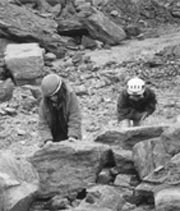
|
||||||
|
|
||||||
|
|
|
On the fossil trail
Igneous rocks, which have been formed either from magma or in the lower layers of the earth under high pressure and high temperatures, are not the place to look for fossils. only in sedimentary rocks can a collector find remnants of plants and animals, and then only if the organisms have been quickly embedded under favorable circumstances, such as in deposits on the floor of prehistoric oceans. Fossils from earlier land regions are usually limted to specific sites such as former lake beds. Fossil collectors need patience, endurance, and experience in order to recognize a fossil-bearing rock from very slim evidence. Seldom will one come across a fossil displayed in flawless beauty, just waiting to be collected. Fossil-bearing rocks are relatively easy to find at large construction sites, where road construction is in progress, or at sites where reservoirs are being built, on riverbanks and steep slopes after a frost, and on sites of landslides, which often yield a harvest of a variety of different fossils. While on a fossil hunt, a collector concentrates on finding rocks that will most-likely bear fossils, breaks those rocks into manageable pieces with a hammer, and tries not to damage the fossils within. Since rocks have distinctive ways of breaking apart, the collector soon learns how to carefully pack the pieces for the trip home. The location and rock formation where the sample was found are carefully recorded on a piece of paper with an indelible pen. After the collector returns home, usually very tired, he or she can put the "treasures" away without worry, saving further work on them until a rainy or cold wintry day. Information above was derived from Fossil Collector's Handbook by Gerhard Lichter, 1993
|
||||
|
|
||||||
